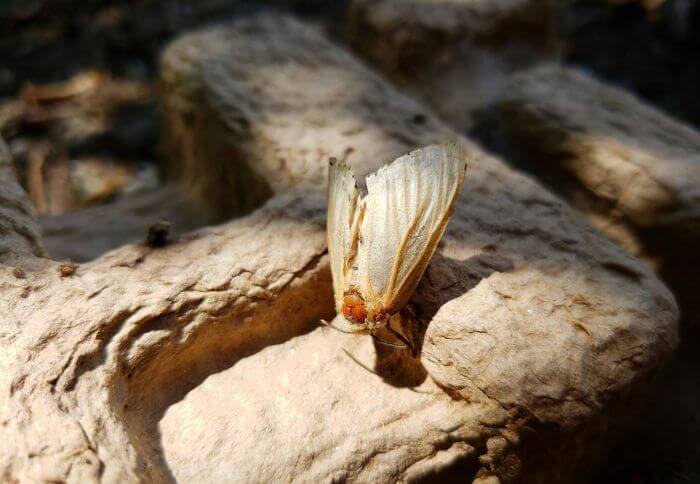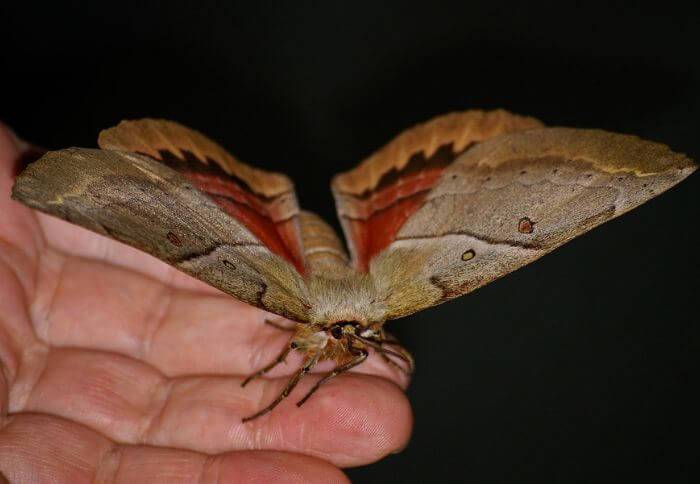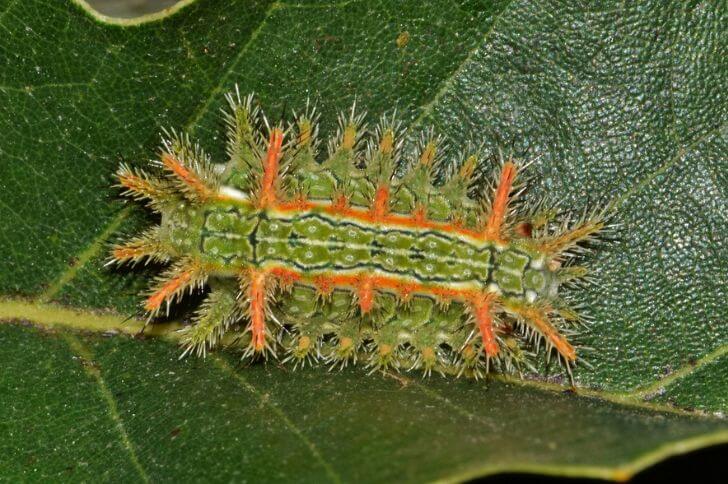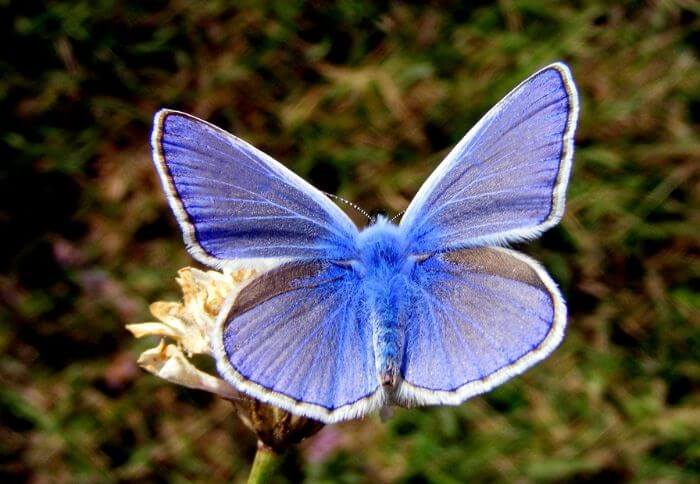5 Caterpillars that Eat Grape Leaves (with Pics)
Caterpillars, those wiggly little creatures that transform into beautiful butterflies, are fascinating creatures when it comes to their dietary habits. These cute and harmless larvae have a diverse range of food preferences, which often astonishes many nature enthusiasts.
While some caterpillars prefer munching on specific plants, others devour a wide variety of vegetation. What’s even more intriguing is their ability to adapt and specialize in order to survive.
One example of such adaptability can be seen in the caterpillars that dine on grape leaves. These particular caterpillar species have developed a remarkable resistance to the toxins found in grape leaves, allowing them to thrive in vineyards without facing significant health consequences.
Moreover, their digestive systems possess unique enzymes that can break down complex compounds present in these leaves. This not only provides them with sustenance but also aids in detoxifying certain chemicals that may harm other organisms.
Caterpillars that eat grape leaves
1. Hyles lineata (white-lined sphinx)
The Hyles lineata, also known as the white-lined sphinx, is a fascinating caterpillar that has developed a particular taste for grape leaves. Unlike other caterpillars that eat grape leaves, the white-lined sphinx stands out with its distinct appearance and feeding habits.
Sporting a green body with bold white lines running along its sides, this magnificent creature is hard to miss amidst the vibrant foliage.
What sets the white-lined sphinx apart from other caterpillars is its ability to adapt to different environments. This resilient species can be found across North America, from arid desert regions to lush gardens and vineyards.
This versatility in habitat enables them to feast on grape leaves throughout their lifecycle, making them both an intriguing study subject for researchers and a potentially daunting threat for grape growers.
Another remarkable aspect of the white-lined sphinx’s behavior is its voracious appetite. While some caterpillars only nibble at small sections of leaves, these creatures consume entire leaves faster than you can imagine.
Each individual caterpillar can devour several square inches of leaf surface every day, stripping vines bare in no time. Their insatiable hunger poses significant challenges for grape farmers who have to find ways to protect their crops from these little leaf-eating machines.
2. Grape Leaf Skeletonizer Caterpillar

One particularly troublesome caterpillar that can wreak havoc on grape leaves is the grape leaf skeletonizer caterpillar. As its name suggests, this caterpillar has a voracious appetite for grape foliage and can quickly strip a vine of its leaves, leaving behind only a skeletal framework.
What makes this caterpillar so special is its ability to blend in with the leaf it feeds on, making it difficult to spot until it has already done significant damage.
The grape leaf skeletonizer caterpillar is not only a nuisance to grape farmers but also poses a threat to the overall health of the plant.
When the leaves are eaten, photosynthesis is significantly reduced, hindering the vine’s ability to produce energy for growth and fruit development. Moreover, defoliation weakens the vine’s natural defense mechanisms against diseases and pests, leaving it more susceptible to other threats such as powdery mildew or spider mites
3. Grape Leaffolder
The Grape Leaffolder is a fascinating caterpillar that not only feeds on grape leaves but also constructs intricate shelters for protection. These shelters, often referred to as leaf “tents,” are created by folding and securing grape leaves with silk threads produced by the caterpillar.
This behavior not only provides shelter from predators, but it also helps to maintain a balanced microclimate within the tent, creating a cozy environment for the caterpillar to thrive.
One of the most interesting aspects of the Grape Leaffolder is its ability to camouflage itself within its folded leaf shelter.
By blending in with its surroundings, the caterpillar can avoid detection by birds and other predators that may be searching for a tasty snack. In fact, if you were to pass by an infested vineyard, it’s quite possible that you might miss these inconspicuous insect tents altogether!
While this little critter may seem harmless at first glance, excessive Grape Leaffolder populations can result in severe damage to grapevines. The constant feeding activity of these caterpillars weakens the leaves and stems, making them susceptible to disease and reducing overall plant health.
Therefore, it becomes essential for vineyard owners to closely monitor their plants during peak leaffolder season and take appropriate measures such as controlled spraying or biological controls to manage these pests effectively.
4. Grape Berry Moth
The Grape Berry Moth, also known as Endopiza viteana, is a common caterpillar that can cause significant damage to grape leaves and fruit. This pest is most active during late spring and early summer, posing a serious threat to vineyards across the United States.
Female moths typically lay eggs on young grape leaves, and once hatched, the larvae feed on the foliage while spinning protective webs.
One interesting aspect of the Grape Berry Moth’s life cycle is its ability to overwinter as pupae in soil or under loose bark. This strategy allows them to survive harsh winter conditions and emerge as adults when temperatures rise.
These resilient caterpillars that eat grape leaves can go through multiple generations per year, making it challenging for vineyard owners to control their populations effectively.
Farmers often employ various management techniques to mitigate the impact of Grape Berry Moths. Some resort to cultural practices like pruning excess vegetation around vines or using efficient irrigation systems that minimize leaf moisture.
Others rely on insecticides targeted at specific stages of the moth’s life cycle, ensuring minimal harm to beneficial insects and pollinators.
Despite being a troublesome pest for vineyards, understanding the biology and behavior of Grape Berry Moths offers valuable insights into ecosystem dynamics.
5. Eumorpha achemon (Achemon sphinx)
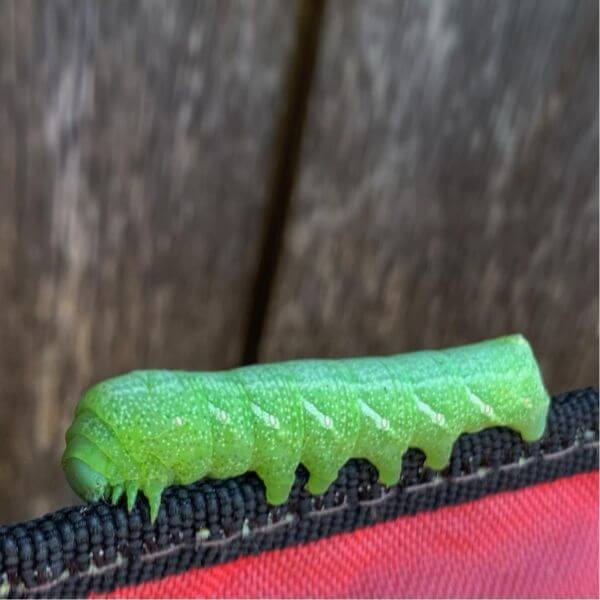
source: chemartistry
Eumorpha achemon, commonly known as the Achemon sphinx, is a fascinating caterpillar that brings both wonder and destruction to the grape leaves it consumes.
With its striking green body and large horn-like appendage at its rear end, this caterpillar is truly a sight to behold in nature’s grand orchestra. However, for grape growers, this creature can be a pest of formidable proportions.
What sets the Achemon sphinx apart from other caterpillars that eat grape leaves is its ability to adopt camouflage tactics. During its feeding stage, it rests on the underside of grape leaves during the day and becomes virtually invisible due to its remarkable resemblance to bird droppings.
This cripsis not only allows it to avoid predators but also provides an advantageous position for obtaining nourishment without being noticed by vigilant vineyard owners.
While the Achemon sphinx may be considered a nuisance by some, it is important to remember that every creature plays a role in our delicate ecosystem.
Its voracious appetite for grape leaves has undoubtedly led growers on an eternal quest for control strategies but witnessing this unique caterpillar in action reminds us of nature’s incredible diversity and resilience.
FAQs about caterpillars that eat grape leaves
How do I get rid of caterpillar in my grapevine?
One of the most frustrating challenges for grapevine owners is dealing with caterpillars that feast on their precious plants. These voracious creatures can quickly strip a vine of its leaves, potentially compromising the health and productivity of the plant.
So, how do you get rid of these unwanted guests? One effective method is to use biological controls such as beneficial insects like ladybugs or lacewings. These natural enemies prey on caterpillars, helping to keep their populations in check and restore balance to your grapevine ecosystem.
Additionally, you can try making your own organic insecticides using ingredients like neem oil or Bacillus thuringiensis (Bt).
Another approach worth considering is implementing cultural practices that deter caterpillar infestations. For instance, maintaining good garden hygiene by regularly removing fallen leaves and debris can help eliminate potential hiding spots for caterpillars before they become a problem.
Moreover, improving air circulation around your grapevine through proper pruning techniques aids in discouraging caterpillar eggs from hatching and larvae from settling on the plant.
It’s important to note that prevention plays a key role in controlling caterpillars on grapevines. By applying physical barriers like netting or screens over your plants during peak pest seasons, you can shield them from adult moths looking to lay their eggs.
Additionally, attracting birds and bats into your garden acts as natural pest control since they feed on these flying insects during dusk when moths are most active.
Will leaves grow back after caterpillars eat them?
If you’ve ever noticed caterpillars munching on the leaves of your grape plants, you may wonder if those leaves will grow back. The good news is that in most cases, leaves can regenerate after being eaten by caterpillars.
Grapevines are resilient plants with the ability to recover from damage caused by pests. However, the rate at which new leaves grow back and their overall health are influenced by various factors.
Firstly, the severity of leaf damage plays a crucial role in determining how quickly new growth occurs. Mild feeding by caterpillars generally results in faster regeneration compared to heavy infestation.
Additionally, grapevines’ growth patterns and timing also influence leaf regrowth. Leaves are typically shed and replaced throughout the growing season as part of normal plant development; therefore, if caterpillar feeding coincides with this natural cycle, the regrowth process is already underway.
Furthermore, the grape variety and its susceptibility to pests can impact leaf regeneration. Some cultivars have inherent resistance to certain insect species or produce compounds that deter feeding activity.
These varieties often exhibit a stronger ability to bounce back from damage inflicted by caterpillars on their leaves.
How long will caterpillar infestation last?
The duration of a caterpillar infestation can vary depending on various factors, including the species of caterpillar and the availability of food sources.
In general, caterpillars go through multiple stages of growth called instars before they pupate into adult butterflies or moths.
One important factor that can influence the length of an infestation is the abundance of food for the caterpillars. If there are plenty of grape leaves available for them to feed on, the infestation may last longer as they continue to consume and grow.
Conversely, if their food supply becomes scarce or is completely depleted, they may search for new host plants or enter a dormant stage until suitable resources become available again.
It’s also worth noting that some species of caterpillars have specific flight periods during which they emerge as adults. This means that even if you successfully deal with an infestation in one year, it doesn’t guarantee that you won’t face another infestation in subsequent years when new generations hatch.
source:

Passionate animal enthusiast and skilled writer with a flair for captivating storytelling. With over five years of experience, I have crafted engaging content that sheds light on the fascinating world of animals.
Through my articles, blog posts, and social media campaigns, I strive to raise awareness about conservation efforts and promote a deeper understanding of the natural world.

